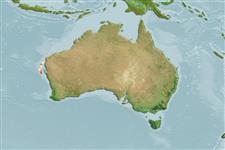Elasmobranchi (squali e razze) (sharks and rays) >
Rajiformes (Skates and rays) >
Arhynchobatidae (Softnose skates)
Etymology: Notoraja: Greek, noton = back + Latin, raja = fish, Raja sp. (Ref. 45335); hirticauda: Named for the dense coverage of fine denticles on both surfaces of the tail, Latin 'hirtus' for rough or bristly and 'cauda' for tail.
More on authors: Last & McEachran.
Environment: milieu / climate zone / distribuzione batimetrica / distribution range
Ecologia
marino benthopelagico; distribuzione batimetrica 500 - 760 m (Ref. 114953). Tropical; 19°S - 27°S, 111°E - 118°E (Ref. 114953)
Eastern Indian Ocean: Western Australia (Shark Bay to Monte Bello Islands).
Length at first maturity / Size / Peso / Age
Maturità: Lm ?, range 36 - ? cm
Max length : 44.8 cm TL maschio/sesso non determinato; (Ref. 75594)
Life cycle and mating behavior
Maturità | Riproduzione | Deposizione | Uova | Fecundity | Larve
Last, P.R. and J.D. McEachran, 2006. Notoraja hirticauda, a new species of skate (Chondrichthyes: Rajoidei) from the south-eastern Indian Ocean. Mem. Mus. Victoria 63(1):65-75. (Ref. 75594)
IUCN Red List Status (Ref. 130435: Version 2025-1)
Threat to humans
Harmless
Human uses
Strumenti
Special reports
Download XML
Fonti Internet
Estimates based on models
Phylogenetic diversity index (Fonte Biblio.
82804): PD
50 = 0.5000 [Uniqueness, from 0.5 = low to 2.0 = high].
Bayesian length-weight: a=0.00562 (0.00288 - 0.01097), b=3.11 (2.94 - 3.28), in cm total length, based on LWR estimates for this (Sub)family-body shape (Ref.
93245).
Trophic level (Fonte Biblio.
69278): 3.7 ±0.7 se; based on size and trophs of closest relatives
Resilienza (Fonte Biblio.
120179): Medio, tempo minimo di raddoppiamento della popolazione 1.4 - 4.4 anni (Preliminary K or Fecundity.).
Fishing Vulnerability (Ref.
59153): Low to moderate vulnerability (35 of 100).
🛈
